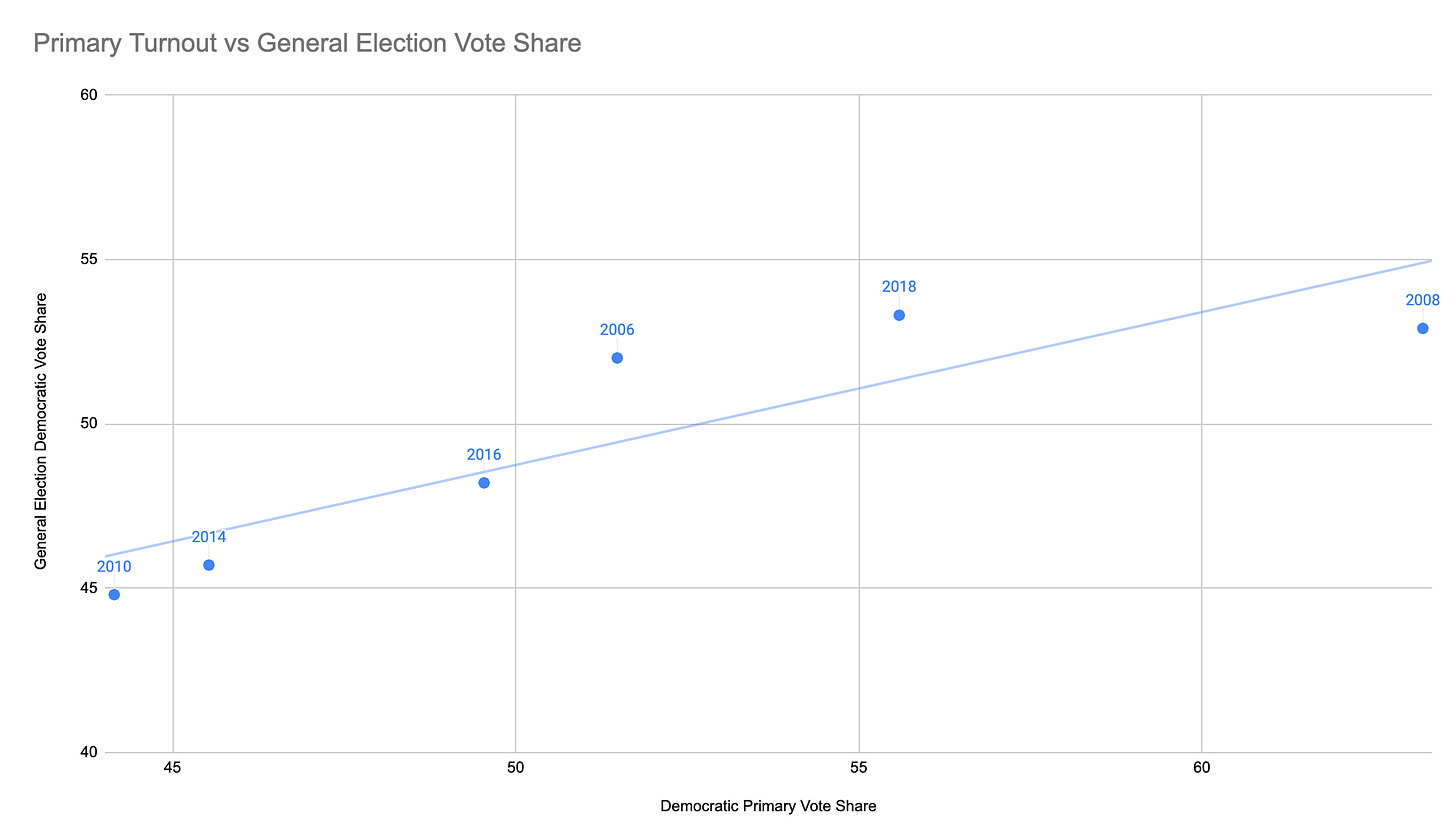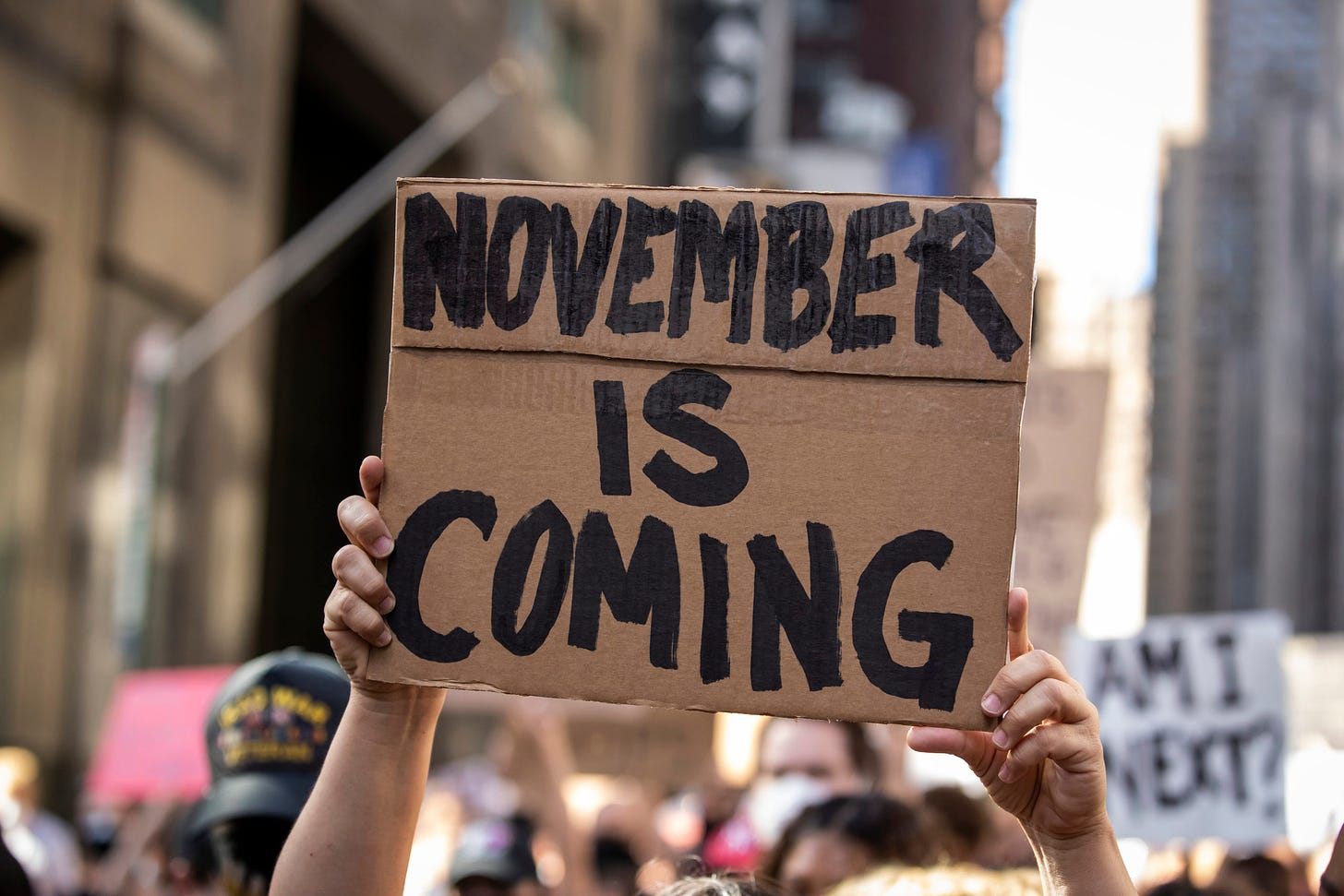Observers look at primary elections as a separate species from general elections. Primaries are viewed both as a signal of which direction a party is headed as well as a determining factor in the outcome of the general election. But we should also pay attention to the partisan composition of primaries, because data shows that the partisan makeup of primaries has been strongly predictive of the final popular vote for the last 15 years.
This implies two tentative conclusions. First, that votes in a primary are not just about how contested the primary is. That is, parties don’t get more votes solely because their primary has a competitive race. Instead, there is a deeper mechanism going on which speaks to voter enthusiasm. When the general election is still months away, primary voters may be expressing their underlying inclinations by voting in the relevant partisan primary, particularly in open primary states where they have freedom to choose which primary they vote in.
Second, this data is interesting because of when primaries happen. Most occur between May and July. The conventional wisdom says that independent voters only tune in and make choices around Labor Day. But the link between primary turnout and general election vote-share suggests that in fact, many voters have made up their minds by mid-summer.
In trying to analyze the correlation between the primary and the general election, we have considered the cycles from 2006 onwards. This is because prior to the turn of the century, Democrats dominated the southern primary vote to such a degree that it skewed the entire country’s numbers and Republicans had no equivalent counterbalance. However, as voters began to shed historical party attachments, the correlation became stronger and stronger. By 2006, it began to have real predictive value.
Below, we plot the Democratic vote share in primaries against the vote share that they earned in the general election, for elections from 2006 to 2018. We see a clear pattern—the better a party’s relative primary turnout, the better their general election performance.

A plot comparing Democratic primary vote share to Democratic general election vote share, from 2006-2018 (2012 was omitted due to several states canceling their Democratic primaries and giving the delegates to President Obama).
In 2006, 2008, and 2018, Democrats dominated primary turnout. They won all three of these general elections by 7 points or more in November. In 2010 and 2014, Democrats saw abysmal primary turnout. Both of those years were Republican waves. With the caveat that the sample size here is small, the correlation does suggest that primary turnout foreshadows voter attitudes for November.
With this tentative link in mind, let’s look at what this thesis would suggest for the 2022 midterms. The current primary season is not over, but the initial data is suggestive. So far, we can track primary turnout in 15 states and make reasonable comparisons to their 2018 primary turnout. In 2018 Republicans outvoted Democrats in those states by 12 points. So far in 2022, Republicans are outvoting Democrats in those same states by 26 points. That 14 point increase for Republicans suggests a good, though perhaps not dominant, environment for them.
However, those numbers don’t tell the whole story. Instead of looking at the overall margin in these states, we can also look at the average margin, which avoids giving extra weight to states that cast more votes. In these fifteen states, in 2018, Republicans outvoted Democrats in the primary by an average of 11 points. In 2022, that average has grown to 31, an increase of 20 points. This would suggest a November 2022 environment more in line with the Republican waves of 2010 or 2014.
Both sets of numbers have merit. The first number gives a more accurate view of what is going on in the aggregate—Republicans are increasing their primary vote share, if not as dramatically as one might expect. But the second number is useful as well. Republicans lag on the first metric because Democrats have seen their primary numbers hold up very well in both Pennsylvania and Texas, and both states cast large numbers of votes. But it is not necessarily clear that Democrats will continue to do well in large states that cast a lot of votes. With about 30 primaries left, it is possible that the variation buoying Democrats here will start to fade.
So what does that tell us about 2022? If Republicans finish the primary season only doing 14 points better than they did in 2018, it would mean they outvote Democrats by 3 points overall in primary vote share. This is enough of a swing to give Republicans an edge, but not a major one in line with a wave election. Using historical data, we would project that Republicans would win the popular vote by around 3 points, depending on the model. However, if Republicans instead end up doing roughly 20 points better in primary vote share, we would project a popular vote win of up to 7 points, which is closer to their 2010 landslide.
In either case, however, the environment does appear to be significantly more Republican in 2022 than in any election cycle since 2014. This means that Democratic candidates seeking to hang on in marginal or GOP-leaning districts would probably need to win by flipping many voters who would otherwise be predisposed to vote Republican. Thus, a Democratic candidate’s crossover strength will be at a premium, because the environment will likely create an electorate that is much more Republican than either 2018 or 2020.
And in an era where crossover voting is plummeting rapidly, such candidates are becoming rarer and rarer.




